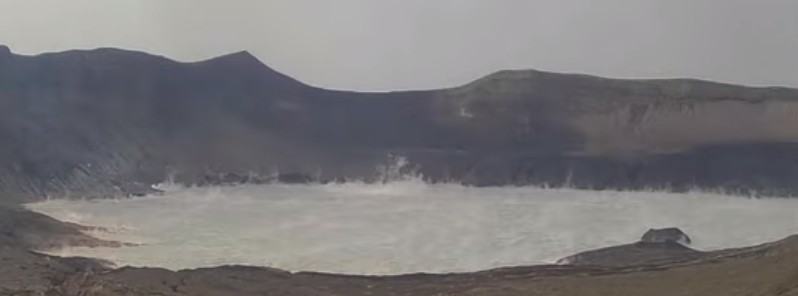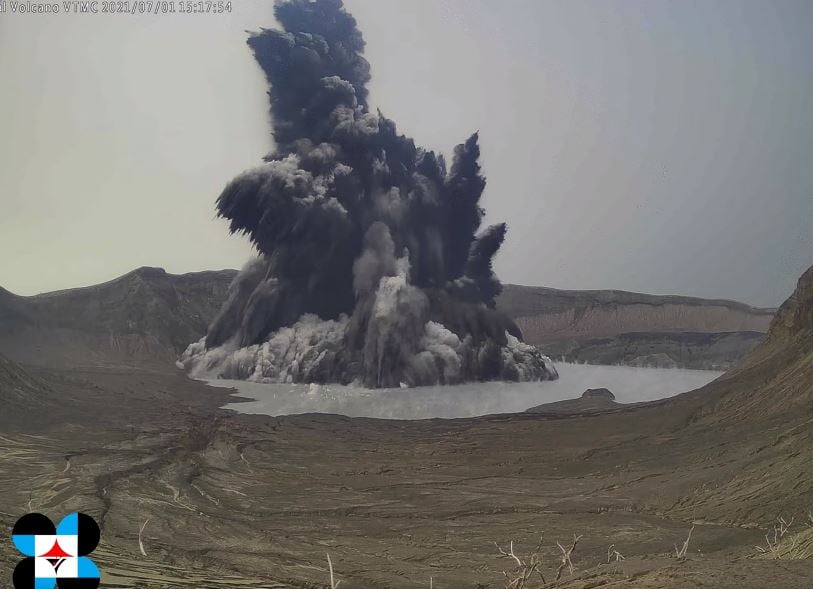Unprecedented high volcanic SO2 degassing at Taal volcano, Philippines

The highest levels of volcanic sulfur dioxide or SO2 gas emission were recorded today, July 4, 2021, at an average of 22 628 tonnes/day — representing the highest ever recorded over Taal, PHIVOLCS reports. The previous record was set on June 28, 2021, with 14 326 tonnes/day.
Since 00:00 UTC on Sunday, July 4 (12:00 LT), a total of 26 strong and very shallow low-frequency volcanic earthquakes associated with magmatic degassing have been recorded beneath the eastern sector of Volcano Island.
Some of these earthquakes were reportedly accompanied by rumbling and weakly felt by fish cage caretakers off the northeastern shorelines of Volcano Island.
These observation parameters may indicate that an eruption similar to the July 1, 2021 event may occur anytime soon.
"In view of the above, DOST-PHIVOLCS is reminding the public that Alert Level 3 prevails over Taal Volcano and that current SO2 parameters indicate ongoing magmatic extrusion at the Main Crater that may further drive succeeding explosions," the agency said.
PHIVOLCS strongly recommends Taal Volcano Island and high-risk barangays of Bilibinwang and Banyaga, Agoncillo and Boso-Boso, Gulod and eastern Bugaan East, Laurel, Batangas Province remain evacuated due to the possible hazards of pyroclastic density currents and volcanic tsunami should stronger eruptions subsequently occur.
According to the Batangas governor, some 15 000 residents have evacuated their homes after the July 1 eruption.
The public is reminded that the entire Taal Volcano Island is a Permanent Danger Zone (PDZ), and entry into the island as well as high-risk barangays of Agoncillo and Laurel must be prohibited.
All activities on Taal Lake should not be allowed at this time, PHIVOLCS added.
Communities around the Taal Lake shores are advised to remain vigilant, take precautionary measures against possible airborne ash and vog and calmly prepare for possible evacuation should unrest intensify.
Because of unprecedented high SO2 degassing from Taal Main Crater, local government units are additionally advised to conduct health checks on communities affected by vog to assess the severity of SO2 impacts on their constituents and to consider temporary evacuation of severely exposed residents to safer areas.
Civil aviation authorities advise pilots to avoid flying over Taal Volcano Island as airborne ash and ballistic fragments from sudden explosions and pyroclastic density currents such as base surges may pose hazards to aircraft.
Its major eruption in January 2020 ejected volcanic ash up to 16.7 km (55 000 feet) above sea level, according to data provided by the Tokyo VAAC. The volcano produced powerful pyroclastic and lava flows, destroying scores of homes, killing livestock, and forcing more than 135 000 people to evacuate.
Taal has produced some of the Philippines' most powerful eruptions. Large pyroclastic flows and surges from historical eruptions have caused many fatalities.
[From our archives: Taal]
July 1, 2021, phreatomagmatic eruption at Taal volcano. Credit: PHIVOLCS


Image credit: PHIVOLCS
Geological summary
Taal is one of the most active volcanoes in the Philippines and has produced some of its most powerful historical eruptions. Though not topographically prominent, its prehistorical eruptions have greatly changed the topography of SW Luzon.
The 15 x 20 km (9 x 12 miles) Talisay (Taal) caldera is largely filled by Lake Taal, whose 267 km2 (103 mi2) surface lies only 3 m (9.8 feet) above sea level.
The maximum depth of the lake is 160 m (525 feet), and several eruptive centers lie submerged beneath the lake. The 5 km (3.1 miles) wide Volcano Island in north-central Lake Taal is the location of all historical eruptions.
The island is composed of coalescing small stratovolcanoes, tuff rings, and scoria cones that have grown about 25% in the area during historical time. Powerful pyroclastic flows and surges from historical eruptions have caused many fatalities. (GVP)
Featured image credit: PHIVOLCS

Commenting rules and guidelines
We value the thoughts and opinions of our readers and welcome healthy discussions on our website. In order to maintain a respectful and positive community, we ask that all commenters follow these rules:
We reserve the right to remove any comments that violate these rules. By commenting on our website, you agree to abide by these guidelines. Thank you for helping to create a positive and welcoming environment for all.